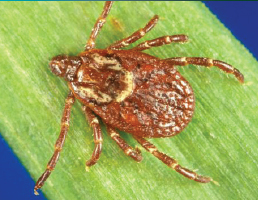NCEZID 2017: Vector-borne

Rocky Mountain spotted fever: New test rapidly detects disease
Rocky Mountain spotted fever (RMSF) is considered the world’s deadliest tickborne disease and, in 2017 an important diagnostic milestone was met. The US Food and Drug Administration (FDA) granted clearance for a test for a family of bacteria called Rickettsia, which causes RMSF and other diseases. The real-time polymerase chain reaction test (PCR) will be offered nationwide through CDC’s Laboratory Response Network. This clearance is the culmination of nearly 20 years and countless hours of work. It is the first FDA-cleared PCR test for detection of rickettsial DNA in clinical diagnostic specimens.
Lyme disease: Researchers work toward improved tests
Properly diagnosing early Lyme disease can be challenging because current tests do not detect infections well during the first few weeks of infection. CDC and Colorado State University researchers are exploring a novel method to look for unique metabolic “fingerprints” found in patients with early Lyme disease. The new method—called metabolomics— can be used to identify and measure molecules the body produces during illness. By identifying these fingerprints, researchers hope to develop improved early Lyme diagnostic tests. Preliminary research has successfully differentiated early Lyme disease from southern tick-associated rash illness.
Researchers hope to develop improved early Lyme diagnostic tests.
Yellow fever: CDC helps respond to epidemics and a domestic vaccine shortage

In 2016-2017 large outbreaks of yellow fever affected Angola, the Democratic Republic of Congo, and Brazil. CDC played a central role in providing technical assistance in response to these epidemics. Yellow fever is caused by a virus spread through bites of infected mosquitoes. It is one of the few vaccine-preventable mosquito-borne diseases. Though once common in parts of the United States, the last major outbreak occurred in 1905. It is now a very rare cause of illness in US travelers. When manufacturing delays led to a depletion of the only US Food and Drug Administration-licensed yellow fever vaccine in the United States in 2017, CDC worked in advance with federal partners and the manufacturer to prepare and ensure that US travelers would have continued access to yellow fever vaccine.
Guillain-Barré syndrome: Study sheds light on link with Zika
Guillain-Barré syndrome (GBS) is an uncommon illness of the nervous system that causes muscle weakness, and in severe cases, respiratory failure. Most patients fully recover from GBS, although some may have permanent damage. Outbreaks of GBS are extremely rare, so when one occurred in French Polynesia during a large outbreak of Zika virus infection in 2013, experts investigated a link between Zika virus infection and GBS. In 2015 and 2016, CDC collaborated with the ministries of health in Brazil and Colombia to perform case-control studies and to gather evidence to explore the possible link between the outbreaks of Zika and GBS. In 2017, CDC, along with the Puerto Rico Department of Health and other partners, conducted the first case-control study in the Americas that showed both laboratory and epidemiologic evidence linking Zika virus infection and GBS. These studies have provided crucial information on the clinical features, risk factors, and outcomes of Zika outbreak-associated GBS.
- Page last reviewed: March 2, 2018
- Page last updated: March 2, 2018
- Content source:
Centers for Disease Control and Prevention
National Center for Emerging and Zoonotic Infectious Diseases (NCEZID)


 ShareCompartir
ShareCompartir